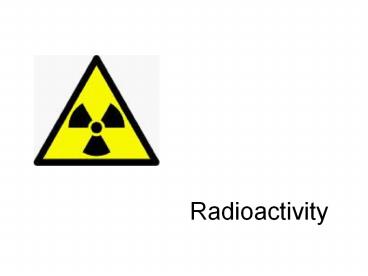Radioactivity PowerPoint PPT Presentation
Title: Radioactivity
1
Radioactivity
2
Structure of an atom
nucleus
protons
neutrons
electrons
3
Nuclear Notation
- Atomic mass (27)
- Protons Neutrons
- Atomic Number (13)
- of protons ( electrons)
27
Al
13
Which of these two numbers can change and still
represent an Aluminum Atom?
4
ISOTOPES
Neutron
- Atoms of the same element that have
different numbers of neutrons
5
and some of them are.UNSTABLE!
- To become more stable, the nucleus will literally
spit out a particle or some energy.
Get outta here!
unstable atoms are called RADIOACTIVE stuff
that is spat out is called RADIATION
6
Radioactive Isotope
- Has an unstable nucleus
- Spontaneously emits a particle and decays into
another element through a process called
transmutation
7
Types of Radioactive Emission
Alpha particles 2 protons 2 neutrons OR Helium nucleus Stopped by a piece of paper Changed into isotope of different element (subtract 2 from atomic number)
Beta Particles Electron Stopped by aluminum Atomic number increases by 1 mass stays same
Gamma radiation High frequency EM wave Stopped by lead Neither mass nor charge is effected
8
When the source of radiation is outside the body,
alpha radiation may not be able to harm the vital
internal organs as it is easily stopped by the
air, layers of clothing or the skin. Gamma
radiation will penetrate the skin. It is more
dangerous than alpha radiation in this case.
9
Half-Life
- The time it takes for half the mass of a
radioactive sample to decay - Ranges from a fraction of a second to billions of
years (Uranium-238) - Is not effected by external conditions
- (The shorter the half-life at which nuclei decay
the more dangerous more alpha, beta, and gamma
rays)
10
Decay Process
- The radioactive isotope is called the parent, and
the isotope formed by the decay is called the
daughter.
11
QUESTION
- What fraction of a radioactive sample has decayed
after two half-lives have elapsed? (a) 1/4
(b) 1/2 (c) 3/4 (d) who knows?
HINT -At the end of the first half-life
interval, half of the original sample has decayed
and half remains. -During the second half-life
interval, half of the remaining portion of the
sample decays.
12
Nuclear Fission
- Unstable nucleus breaks apart to form two lighter
nuclei - Mass of particles produced is slightly less than
the mass of the reactants. - This mass is converted to energy (E mc²)
13
Nuclear Fission
- Uranium-235 combines with a neutron to form an
unstable intermediate, which quickly splits into
barium-144 and krypton-89 plus three neutrons in
the process of nuclear fission.
14
Nuclear Fission
Fission occurs when an unstable nucleus breaks
apart to form two lighter nuclei. It may be
spontaneous, but in most cases requires the
absorption of a stray neutron. In addition it
may emit radiation, one or more neutrons and some
heat energy.
CONTROLLED UNCONTROLLED
Nuclear Power The
Atom Bomb
15
Nuclear Reactors
- Control fission chain reactions
to produce energy - Use nuclear fission to produce heat, which then
is used to generate steam for running turbines. - Turbines generate electricity for homes
- Dangers
- Radioactive by products- nuclear waste (must be
stored safely and permanently) - Meltdowns- cooling towers must run constantly to
reduce heat produced by reactors
16
Neutron to start the reaction
Each fission event splits the uranium into two
smaller fragments.a few more neutrons.and
releases energy
Uranium atom
17
235 1 236 92
142 1 U n ? U ?
Kr Ba 2 n 92 0
92 36 56
0
If the nuclei are packed together close enough
the extra neutrons will collide with other
uranium nuclei and produce a chain reaction. The
equation above describes one fission event.
18
(No Transcript)
19
- The mushroom cloud of the atom bomb dropped on
Nagasaki, Japan in 1945 rose some 18 kilometers
(11 miles) above the bomb's hypocenter.
20
When a chain reaction is allowed to continue
unchecked, a vast amount of heat and radiation is
released in a very short time. The effects of an
atomic bomb is devastating and long lasting!
21
The mushroom cloud produced is a spectacular
sight, but a sign of terrible things to come.
Click here to link to a site with old videos of
an atom bomb explosion test carried out by the
U.S.A.
22
Nuclear Fusion
- Combination of 2 nuclei into one with release of
energy - Mass of particles produced is much less than the
mass of the original Hs. This mass is converted
into energy (E mc²)
23
Nuclear Fusion
- Deuterium and tritium combine by nuclear fusion
to form Helium and a neutron

